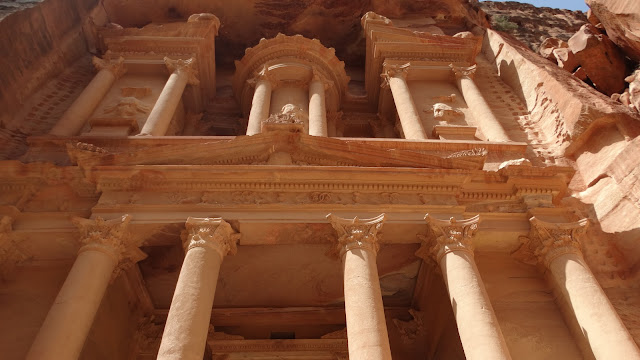Petra (Arabic: البتراء, Al-Batrāʾ; Ancient Greek: Πέτρα), originally known as Raqmu, is a historical and archaeological city in southern Jordan. Petra lies on the slope of Jabal Al-Madbah in a basin among the mountains which form the eastern flank of Arabah valley that run from the Dead Sea to the Gulf of Aqaba. Petra is believed to have been settled as early as 9,000 BC, and it was possibly established in the 4th century BC as the capital city of the Nabataean Kingdom. The Nabataeans were nomadicArabs who invested in Petra's proximity to the trade routes by establishing it as a major regional trading hub.[3]
The trading business gained the Nabataeans considerable revenue and Petra became the focus of their wealth, drawing the envy of its neighbors. The earliest recorded historical reference to Petra was when the Greek Antigonids raided the city in 312 BC. The Nabataeans were, unlike their enemies, accustomed to living in the barren deserts, and were able to repel attacks by utilizing the area's mountainous terrain. They were particularly skillful in harvesting rainwater, agriculture and stone carving. Petra flourished in the 1st century AD when its famous Khazneh structure–believed to be themausoleum of Nabataean King Aretas IV–was constructed, and its population peaked at an estimated 20,000 inhabitants.[4]
Although the Nabataean Kingdom became a client state for the Roman Empire in the first century BC, it was only in 106 AD that they lost their independence. Petra fell to the Romans who annexed and renamed Nabataea to Arabia Petraea. Petra's importance declined as sea trade routes emerged, and after a 363 earthquake destroyed many structures. The Byzantine Era witnessed the construction of several Christian churches, but the city continued to decline, and by the early Islamic era became an abandoned place where only a handful of nomads lived. It remained unknown to the world until it was rediscovered in 1812 by Johann Ludwig Burckhardt.[5]
The city is accessed through a 1.2 kilometres (0.75 mi) long gorge called the Siq, which leads directly to the Khazneh. Famous for its rock-cut architecture and water conduit system, Petra is also called the Rose City due to the color of the stone out of which it is carved.[6] It has been a UNESCO World Heritage Site since 1985. UNESCO has described it as "one of the most precious cultural properties of man's cultural heritage".[7] In 2007, Al-Khazneh was voted in as one of the New7Wonders of the World. Petra is a symbol of Jordan, as well as Jordan's most-visited tourist attraction. Tourist numbers peaked at 1 million in 2010, the following period witnessed a slump due to regional instability. However, tourist numbers have picked up recently, and around 600,000 tourists visited the site in 2017.
Hello My Dear Great Ones,
Petra is amazing! Walking into it is amazing, coming onto the Al Khazneh (The Treasury)is amazing! Below are some pictures that hopefully give testimony to this fact. It is amazing!
Along the way were things carved right into the stone.
A fellow tourist taking a break.
Finally after a lengthy meander one goes through a narrow portal to alight to this:
Al Khazneh (The Treasury) made famous in Indiana Jones.
Some dudes hanging out.
There were camel rides for tourists. Here is one getting a ride.
Swarthy camel owners enjoyed a solid business from the multitudes of tourists.
Near the treasury are many carved out "buildings,"and statues.
This open area theatre was carved right out of stone.
Amazing!
Petra is an amazing place!
Have a great week!
Love adios and ping on!
Dirk







































No comments:
Post a Comment
Note: Only a member of this blog may post a comment.